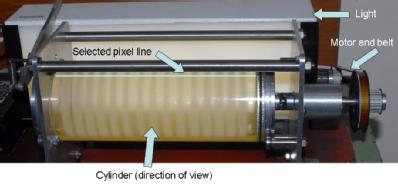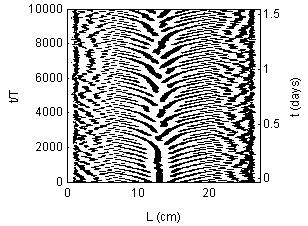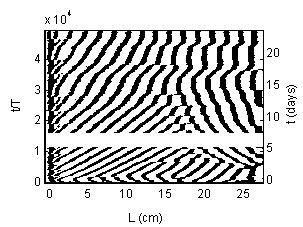Particle-laden rimming flow
We study a segregation phenomenon in a simple, generic flow configuration commonly referred to as rimming flow. Particle segregation and clustering in fluid-granule mixtures bears relevance to numerous industrial processes where homogeneous mixtures are essential (e.g. pharmaceutical industry, food processing, biotechnology) - undesired clustering is detrimental to product quality.
Rimming flow is the flow established inside a partially fluid-filled cylinder when it rotates around a horizontal axis of rotation. Boote and Thomas (1999) and Thomas et al. (2001) investigated rimming flow for the case when the liquid carries small particles with densities higher or lower than that of the fluid. They found that the particles can segregate to form a series of successive granule-rich azimuthal bands, separated from one another by a fluid region with power particle concentrations or a region entirely free of granules as illustrated in Fig 1.
Experimental conditions:
A horizontal transparent circular cylinder of specific length and radius rotates around a horizontal axis by means of a variable-speed motor and a pulley-and-belt drive. It is filled by a control volume of fluid and particles. The working fluid is usually a silicone oil chosen for its specific density, surface tension and viscosity. The particles (usually glass beads) are selected for their shape (spherical), their dimension and density. To monitor the experiments we used a programmable digital camera. Photographs are taken regular intervalls of time. The photographs are directly transferred to a PC for storage and data processing. For the data processing of each photograph we extracted a horizontal pixel line at a position corresponding approxiamtely to that indicated in Fig. 1. Each pixel line was processed such that the location of the bands with high particle concentrations are represented in black whereas granule free regions or regions with low particle concentrations appear in white. The pixel lines extracted from the successive photographs of an experiment were then stacked into a single image to compose a spatio-temporal plot.

Results:
In Guyez and Thomas (PRL, 2008![]() ) we reported that the banding pattern can display a very complex and often highly symmetric spatiotemporal behavior that emerges on time scales of days or weeks as the granule bands drift very slowly along the direction of the cylinder axis. We identified a number of different characteristic drift modes. For instance, it was observed that the bands can either drift from the end walls of the cylinder towards its center or from positions along the cylinder axis towards the end walls. Sometimes the bands oscillate irregularly in space and time and sometimes they remain entirely stationary.
) we reported that the banding pattern can display a very complex and often highly symmetric spatiotemporal behavior that emerges on time scales of days or weeks as the granule bands drift very slowly along the direction of the cylinder axis. We identified a number of different characteristic drift modes. For instance, it was observed that the bands can either drift from the end walls of the cylinder towards its center or from positions along the cylinder axis towards the end walls. Sometimes the bands oscillate irregularly in space and time and sometimes they remain entirely stationary.


There is eight non-dimensional parameters that affect the flow. We have studied the influence of each of them in term of particles segregation, drift velocity and direction of the bands (pattern formation), formation of droplets. The 2 coming articles are summarizing these results.
SUPERVISOR: Dr Peter J. Thomas, Professor, pjt1@eng.warwick.ac.uk
